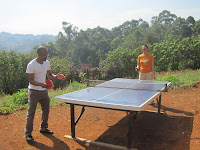On December 7 the first Northwest Region Anesthesia Meeting was held here in Shisong. It was well attended and well received by English speaking anesthetists from the region and beyond. If there was a flaw, it was in trying to do too much but there was a variety of topics and speakers. The organizers are to be congratulated and I am sure that more conferences will be held in the future.
On December 9 I attended the horse races in Tobin, the administrative center of Kumbo. They even had ice cream (or some sort of cold treat).
Valentina is an Italian physician who remained in Shisong after the San Donato mission to do some database work at the cardiac center. Before she left, she and Dr. Charles and I had a cut-throat Ping-Pong tournament. I will not say publicly who won.
On December 15 I traveled to Yaounde with Sr. Jethro, Brother Boniface, and Sr. Terese to extend my visa and pay some Christmas visits to various offices in Yaounde that work with the Cardiac Center. While there, I met Maria and Brad Festen who work with SIL International in the Central African Republic. They are in Cameroon due to the current troubles in the CAR and they generously hosted all of us for dinner. We also took Sr. Terese on her first elevator ride and visited with Sr. Apollonia who is in Yaounde working on a communications degree. I promised I would not post her picture in her kitchen-work clothes so instead I am posting this one of Sr. Jethro crushing pumpkin seeds with a stone.
After returning from Yaounde, of course, it was time to prepare to celebrate Christmas. There is a large Catholic population and a significant Protestant population here in Kumbo, and the non-Christians also wish everyone well at this time. The ICU staff had a Christmas party at a local hotel, which coincided with the Cameroon Cup championship football (soccer) match, so in addition to good food and drinks, we were able to celebrate the win of the Bamenda team over the Yaounde team. The hospital also held parties for numerous groups of staff complete with Christmas caroling.
Christmas trees look a little different here but the idea is there. I’m sure that Logan and Eric did eventually decorate their tree! I went there to help but had to leave before we actually hung anything on the tree.
The novices of the Tertiary Sisters put on a Christmas play on Christmas Eve before Mass. It was very well done, beginning with Adam and Eve and their choice to reject God’s love, then walking us through the (very enthusiastic) prophets, and taking us through the birth of Christ with (very enthusiastic) angels and shepherds, one reluctant goat, and wise men visiting a conniving Herod. A newborn from the maternity ward played the part of Jesus. All of this revelry was followed by a beautiful Christmas Vigil Mass and a celebratory Christmas Day.
Following Christmas Kumbo holds a “Cultural Week.” The palace, villages, and family groups participate in traditional dances and other activities.


















































